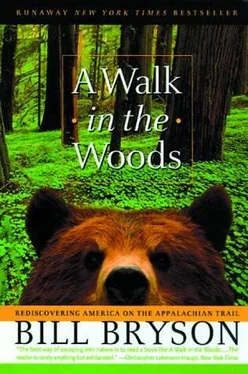Bill Bryson - A Walk In The Woods
Здесь есть возможность читать онлайн «Bill Bryson - A Walk In The Woods» весь текст электронной книги совершенно бесплатно (целиком полную версию без сокращений). В некоторых случаях можно слушать аудио, скачать через торрент в формате fb2 и присутствует краткое содержание. Жанр: Современная проза, на английском языке. Описание произведения, (предисловие) а так же отзывы посетителей доступны на портале библиотеки ЛибКат.
- Название:A Walk In The Woods
- Автор:
- Жанр:
- Год:неизвестен
- ISBN:нет данных
- Рейтинг книги:4 / 5. Голосов: 1
-
Избранное:Добавить в избранное
- Отзывы:
-
Ваша оценка:
- 80
- 1
- 2
- 3
- 4
- 5
A Walk In The Woods: краткое содержание, описание и аннотация
Предлагаем к чтению аннотацию, описание, краткое содержание или предисловие (зависит от того, что написал сам автор книги «A Walk In The Woods»). Если вы не нашли необходимую информацию о книге — напишите в комментариях, мы постараемся отыскать её.
A Walk In The Woods — читать онлайн бесплатно полную книгу (весь текст) целиком
Ниже представлен текст книги, разбитый по страницам. Система сохранения места последней прочитанной страницы, позволяет с удобством читать онлайн бесплатно книгу «A Walk In The Woods», без необходимости каждый раз заново искать на чём Вы остановились. Поставьте закладку, и сможете в любой момент перейти на страницу, на которой закончили чтение.
Интервал:
Закладка:
In fact, mostly what the Forest Service does is build roads. I am not kidding. There are 378,000 miles of roads in America’s national forests. That may seem a meaningless figure, but look at it this way-it is eight times the total mileage of America’s interstate highway system. It is the largest road system in the world in the control of a single body. The Forest Service has the second highest number of road engineers of any government institution on the planet. To say that these guys like to build roads barely hints at their level of dedication. Show them a stand of trees anywhere and they will regard it thoughtfully for a long while, and say at last, “You know, we could put a road here.” It is the avowed aim of the U.S. Forest Service to construct 580,000 miles of additional forest road by the middle of the next century.
The reason the Forest Service builds these roads, quite apart from the deep pleasure of doing noisy things in the woods with big yellow machines, is to allow private timber companies to get to previously inaccessible stands of trees. Of the Forest Service’s 150 million acres of loggable land, about two-thirds is held in store for the future. The remaining one-third-49 million acres, or an area roughly twice the size of Ohio-is available for logging. It allows huge swathes of land to be clear-cut, including (to take one recent but heartbreaking example) 209 acres of thousand-year-old redwoods in Oregon’s Umpqua National Forest.
In 1987, it casually announced that it would allow private timber interests to remove hundreds of acres of wood a year from the venerable and verdant Pisgah National Forest, next door to the Great Smoky Mountains National Park, and that 80 percent of that would be through what it delicately calls “scientific forestry”-clear-cutting to you and me-which is not only a brutal visual affront to any landscape but brings huge, reckless washoffs that gully the soil, robbing it of nutrients and disrupting ecologies farther downstream, sometimes for miles. This isn’t science. It’s rape.
And yet the Forest Service grinds on. By the late 1980s-this is so extraordinary I can hardly stand it-it was the only significant player in the American timber industry that was cutting down trees faster than it replaced them. Moreover, it was doing this with the most sumptuous inefficiency. Eighty percent of its leasing arrangements lost money, often vast amounts. In one typical deal, the Forest Service sold hundred-year-old lodgepole pines in the Targhee National Forest in Idaho for about $2 each after spending $4 per tree surveying the land, drawing up contracts, and, of course, building roads. Between 1989 and 1997, it lost an average of $242 million a year-almost $2 billion all told, according to the Wilderness Society. This is all so discouraging that I think we’ll leave it here and return to our two lonely heroes trudging through the lost world of the chattahoochee.
The forest we walked through now was really just a strapping adolescent. In 1890, a railroad man from Cincinnati named Henry C. Bagley came to this part of Georgia, saw the stately white pines and poplars, and was so moved by their towering majesty and abundance that he decided to chop them all down. They were worth a lot of money. Besides, freighting the timber to northern mills would keep his railroad cars puffing. In consequence, over the next thirty years, nearly all the hills of northern Georgia were turned into sunny groves of stumps. By 1920, foresters in the South were taking away 15.4 billion board feet of timber a year. It wasn’t until the 1930s, when the chattahoochee Forest was officially formed, that nature was invited back in.
There is a strange frozen violence in a forest out of season. Every glade and dale seemed to have just completed some massive cataclysm. Downed trees lay across the path every fifty or sixty yards, often with great bomb craters of dirt around their splayed roots. Dozens more lay rotting on the slopes, and every third or fourth tree, it seemed, was leaning steeply on a neighbor. It was as if the trees couldn’t wait to fall over, as if their sole purpose in the universal scheme of things was to grow big enough to topple with a really good, splintering crash. I was forever coming up to trees so precariously and weightily tipped over the path that I would waver, then scoot under, fearing the crush of really unfortunate timing and imagining Katz coming along a few minutes later, regarding my wriggling legs and saying, “Shit, Bryson, what’re you doing under there?” But no trees fell. Everywhere the woods were still and preternaturally quiet. Except for the occasional gurgle of running water and the tiny shuffle of wind-stirred leaves along the forest floor, there was almost never a sound.
The woods were silent because spring had not yet come. In a normal year we would be walking into the zestful bounty of a southern mountain spring, through a radiant, productive, newborn world alive with the zip of insects and the fussy twitter of birds-a world bursting with fresh wholesome air and that rich, velvety, lung-filling smell of chlorophyll you get when you push through low, leafy branches. Above all, there would be wildflowers in dazzling profusion, blossoming from every twig, pushing valiantly through the fertile litter on the forest floor, carpeting every sunny slope and stream bank-trillium and trailing arbutus, Dutchmen’s breeches, jack-in-the-pulpit, mandrake, violets, snowy bluets, buttercups and bloodroot, dwarf iris, columbine and wood sorrel, and other cheerful, nodding wonders almost beyond counting. There are 1,500 types of wildflower in the southern Appalachians, 40 rare types in the northern Georgia woods alone. They are a sight to lift the hardest heart. But they were not to be seen in the woods this grim March. We trudged through a cold, silent world of bare trees, beneath pewter skies, on ground like iron.
We fell into a simple routine. Each morning we rose at first light, shivering and rubbing arms, made coffee, broke down camp, ate a couple of fistfuls of raisins, and set off into the silent woods. We would walk from about half past seven to four. We seldom walked together-our paces didn’t match-but every couple of hours I would sit on a log (always surveying the surrounding undergrowth for the rustle of bear or boar) and wait for Katz to catch up, to make sure everything was OK. Sometimes other hikers would come along and tell me where Katz was and how he was progressing, which was nearly always slowly but gamely. The trail was much harder for him than for me, and to his credit he tried not to bitch. It never escaped me for a moment that he didn’t have to be there.
I had thought we would have a jump on the crowds, but there was a fair scattering of other hikers-three students from Rutgers University in New Jersey; an astoundingly fit older couple with tiny packs hiking to their daughter’s wedding in far-off Virginia; a gawky kid from Florida named Jonathan-perhaps two dozen of us altogether in the same general neck of the woods, all heading north. Because everyone walks at different rates and rests at different times, three or four times a day you bump into some or all of your fellow hikers, especially on mountaintops with panoramic views or beside streams with good water, and above all at the wooden shelters that stand at distant intervals, ostensibly but not always actually, a day’s hike apart in clearings just off the trail. In consequence you get to know your fellow hikers at least a little, quite well if you meet them nightly at the shelters. You become part of an informal clump, a loose and sympathetic affiliation of people from different age groups and walks of life but all experiencing the same weather, same discomforts, same landscapes, same eccentric impulse to hike to Maine.
Even at busy times, however, the woods are great providers of solitude, and I encountered long periods of perfect aloneness, when I didn’t see another soul for hours; many times when I would wait for Katz for a long spell and no other hiker would come along. When that happened, I would leave my pack and go back and find him, to see that he was all right, which always pleased him. Sometimes he would be proudly bearing my stick, which I had left by a tree when I had stopped to tie my laces or adjust my pack. We seemed to be looking out for each other. It was very nice. I can put it no other way.
Читать дальшеИнтервал:
Закладка:
Похожие книги на «A Walk In The Woods»
Представляем Вашему вниманию похожие книги на «A Walk In The Woods» списком для выбора. Мы отобрали схожую по названию и смыслу литературу в надежде предоставить читателям больше вариантов отыскать новые, интересные, ещё непрочитанные произведения.
Обсуждение, отзывы о книге «A Walk In The Woods» и просто собственные мнения читателей. Оставьте ваши комментарии, напишите, что Вы думаете о произведении, его смысле или главных героях. Укажите что конкретно понравилось, а что нет, и почему Вы так считаете.












